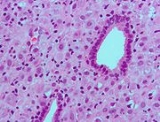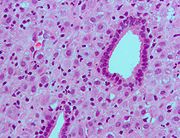
Progesterone only pill
Encyclopedia
Progestogen-Only Pills or Progestin-Only Pills (POP) are contraceptive pills that contain only synthetic progestogens (progestin
s) and do not contain estrogen
. They are colloquially known as mini pills.
Although such pills are sometimes called "Progesterone-Only Pills", they do not actually contain progesterone
, but one of several chemically related compounds; and there are a number of progestogen only contraceptive formulations.
 The mechanism of action of progestogen-only contraceptives depends on the progestogen activity and dose.
The mechanism of action of progestogen-only contraceptives depends on the progestogen activity and dose.
In anovulatory cycles
using progestogen-only contraceptives, the endometrium is thin and atrophic. If the endometrium were also thin and atrophic during an ovulatory cycle, this could, in theory, interfere with implantation of a blastocyst (embryo).
POPs are not dependent upon gut bacterial flora
for their absorption and so are not affected by courses of antibiotics. They will, however, be affected by any episodes of diarrhea or vomiting.
. With the decreased clotting risk, they are not contraindicated in the setting of sickle-cell disease
. The progestin-only pill is recommended over regular birth control pills for women who are breastfeeding
because the mini-pill does not affect milk production (estrogen reduces the amount of breast milk). Like combined pills, the minipill decreases the likelihood of pelvic inflammatory disease
.
It is unclear whether POPs provide protection against endometrial cancer
and ovarian cancer
to the extent that COCP do.
There are fewer serious complications than on COCP.
In the largest (1996) reanalysis of previous studies of hormonal contraceptives and breast cancer risk, less than 1% were POP users. Current or recent POP users had a slightly increased relative risk (RR 1.17) of breast cancer diagnosis that just missed being statistically significant. The relative risk was similar to that found for current or recent COCP users (RR 1.16), and, as with COCPs, the increased relative risk decreased over time after stopping, vanished after 10 years, and was consistent with being due to earlier diagnosis or promoting the growth of a preexisting cancer.
The most recent (1999) IARC
evaluation of progestogen-only hormonal contraceptives reviewed the 1996 reanalysis as well as 4 case-control studies of POP users included in the reanalysis. They concluded that: "Overall, there was no evidence of an increased risk of breast cancer" with progestogen-only contraceptives, but since there was "inadequate evidence", they were "possibly carcinogenic".
Recent anxieties about the contribution of progestogens to the increased risk of breast cancer associated with HRT
in postmenopausal women such as found in the WHI
trials have not spread to progestogen-only contraceptive use in premenopausal women.
Progestin
A progestin is a synthetic progestogen that has progestinic effects similar to progesterone. The two most common uses of progestins are for hormonal contraception , and to prevent endometrial hyperplasia from unopposed estrogen in hormone replacement therapy...
s) and do not contain estrogen
Estrogen
Estrogens , oestrogens , or œstrogens, are a group of compounds named for their importance in the estrous cycle of humans and other animals. They are the primary female sex hormones. Natural estrogens are steroid hormones, while some synthetic ones are non-steroidal...
. They are colloquially known as mini pills.
Although such pills are sometimes called "Progesterone-Only Pills", they do not actually contain progesterone
Progesterone
Progesterone also known as P4 is a C-21 steroid hormone involved in the female menstrual cycle, pregnancy and embryogenesis of humans and other species...
, but one of several chemically related compounds; and there are a number of progestogen only contraceptive formulations.
Mechanism of action

- Very-low-dose progestogen-only contraceptives, such as traditional progestogen-only pills (and subdermal implants NorplantNorplantNorplant is a form of birth control developed by the Population Council that was first approved in 1983 in Finland, where it was manufactured by Leiras Oy Pharmaceuticals...
and Jadelle and intrauterine systemsIntraUterine SystemThe IUD with progestogen, intrauterine system , or IntraUterine Contraceptive is a long-acting reversible hormonal contraceptive device that is placed in the uterus. An IUS has a hormone cylinder that releases a progestin called levonorgestrel...
Progestasert and Mirena), inconsistently inhibit ovulation in ~50% of cycles and rely mainly on their progestogenic effect of thickening the cervical mucus, thereby reducing sperm viability and penetration. - Intermediate-dose progestogen-only contraceptives, such as the progestogen-only pill Cerazette (or the subdermal implant ImplanonImplanonImplanon, made by Organon International, is a single-rod long acting reversible hormonal contraceptive subdermal implant that is inserted just under the skin of a woman's upper arm. The 4 cm by 2 mm Implanon rod contains 68 milligrams of etonogestrel which is released over a three year...
), allow some follicular development (part of the steps of ovulation) but much more consistently inhibit ovulation in 97–99% of cycles. The same cervical mucus changes occur as with very-low-dose progestogens. - High-dose progestogen-only contraceptives, such as the injectables Depo-Provera and Noristerat, completely inhibit follicular development (see above) and ovulation. The same cervical mucus changes occur as with very-low-dose and intermediate-dose progestogens.
In anovulatory cycles
Anovulation
An anovulatory cycle is a menstrual cycle during which the ovaries do not release an oocyte. Therefore, ovulation does not take place. However, a woman who does not ovulate at each menstrual cycle is not necessarily going through menopause...
using progestogen-only contraceptives, the endometrium is thin and atrophic. If the endometrium were also thin and atrophic during an ovulatory cycle, this could, in theory, interfere with implantation of a blastocyst (embryo).
Efficacy and effectiveness
The theoretical efficacy is similar to that of the combined oral contraceptive pill (COCP). However, this pill is taken continuously without any breaks between packets, and traditional progestogen-only pills must be taken to a much stricter time every day (within 3 hours vs. a COCP's 12 hours. However, in some countries, the POP Cerazette has an approved window of 12 hours). The effectiveness is, therefore, dependent upon compliance.POPs are not dependent upon gut bacterial flora
Flora (microbiology)
In microbiology, flora refers to the collective bacteria and other microorganisms in an ecosystem . While the term microflora is widely used, it is technically a misnomer since the word root flora pertains to the kingdom plantae...
for their absorption and so are not affected by courses of antibiotics. They will, however, be affected by any episodes of diarrhea or vomiting.
Benefits
Lacking the estrogen of combined pills, they are not associated with increased risks of DVT or heart diseaseHeart disease
Heart disease, cardiac disease or cardiopathy is an umbrella term for a variety of diseases affecting the heart. , it is the leading cause of death in the United States, England, Canada and Wales, accounting for 25.4% of the total deaths in the United States.-Types:-Coronary heart disease:Coronary...
. With the decreased clotting risk, they are not contraindicated in the setting of sickle-cell disease
Sickle-cell disease
Sickle-cell disease , or sickle-cell anaemia or drepanocytosis, is an autosomal recessive genetic blood disorder with overdominance, characterized by red blood cells that assume an abnormal, rigid, sickle shape. Sickling decreases the cells' flexibility and results in a risk of various...
. The progestin-only pill is recommended over regular birth control pills for women who are breastfeeding
Breastfeeding
Breastfeeding is the feeding of an infant or young child with breast milk directly from female human breasts rather than from a baby bottle or other container. Babies have a sucking reflex that enables them to suck and swallow milk. It is recommended that mothers breastfeed for six months or...
because the mini-pill does not affect milk production (estrogen reduces the amount of breast milk). Like combined pills, the minipill decreases the likelihood of pelvic inflammatory disease
Pelvic inflammatory disease
Pelvic inflammatory disease is a generic term for inflammation of the uterus, fallopian tubes, and/or ovaries as it progresses to scar formation with adhesions to nearby tissues and organs. This may lead to infections. PID is a vague term and can refer to viral, fungal, parasitic, though most...
.
It is unclear whether POPs provide protection against endometrial cancer
Endometrial cancer
Endometrial cancer refers to several types of malignancies that arise from the endometrium, or lining, of the uterus. Endometrial cancers are the most common gynecologic cancers in the United States, with over 35,000 women diagnosed each year. The incidence is on a slow rise secondary to the...
and ovarian cancer
Ovarian cancer
Ovarian cancer is a cancerous growth arising from the ovary. Symptoms are frequently very subtle early on and may include: bloating, pelvic pain, difficulty eating and frequent urination, and are easily confused with other illnesses....
to the extent that COCP do.
Side-effects
- With no break in the dosage, menstrual flow does not initially occur at a predictable time. Most women tend to establish, over a few months, light spotting at approximately regular intervals.
- May cause mastalgiaMastalgiaMastodynia, mastalgia or mammalgia are names for a medical symptom that means breast pain .Pain can range from minor discomfort to severely incapacitating pain...
(breast tenderness) or mood swings. - Weight gain is less commonly experienced than on COCP.
- Some women may experience abdominal cramps and heavy bleeding.
There are fewer serious complications than on COCP.
Breast cancer risk
Epidemiological evidence on POPs and breast cancer risk is based on much smaller populations of users and so is less conclusive than that for COCPs.In the largest (1996) reanalysis of previous studies of hormonal contraceptives and breast cancer risk, less than 1% were POP users. Current or recent POP users had a slightly increased relative risk (RR 1.17) of breast cancer diagnosis that just missed being statistically significant. The relative risk was similar to that found for current or recent COCP users (RR 1.16), and, as with COCPs, the increased relative risk decreased over time after stopping, vanished after 10 years, and was consistent with being due to earlier diagnosis or promoting the growth of a preexisting cancer.
The most recent (1999) IARC
International Agency for Research on Cancer
The International Agency for Research on Cancer is an intergovernmental agency forming part of the World Health Organisation of the United Nations....
evaluation of progestogen-only hormonal contraceptives reviewed the 1996 reanalysis as well as 4 case-control studies of POP users included in the reanalysis. They concluded that: "Overall, there was no evidence of an increased risk of breast cancer" with progestogen-only contraceptives, but since there was "inadequate evidence", they were "possibly carcinogenic".
Recent anxieties about the contribution of progestogens to the increased risk of breast cancer associated with HRT
Hormone replacement therapy (menopause)
Hormone replacement therapy is a system of medical treatment for surgically menopausal, perimenopausal and to a lesser extent postmenopausal women...
in postmenopausal women such as found in the WHI
Women's Health Initiative
The Women's Health Initiative was initiated by the U.S. National Institutes of Health in 1991. The objective of this women's health research initiative was to conduct medical research into some of the major health problems of older women...
trials have not spread to progestogen-only contraceptive use in premenopausal women.

